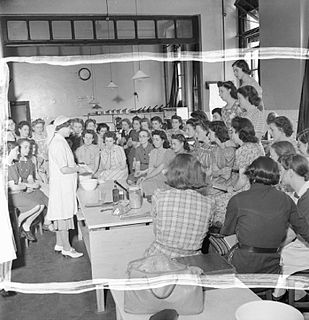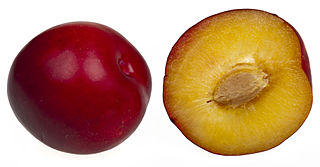
A plum is a fruit of the subgenus Prunus of the genus Prunus. The subgenus is distinguished from other subgenera in the shoots having terminal bud and solitary side buds, the flowers in groups of one to five together on short stems, and the fruit having a groove running down one side and a smooth stone.

Toxicodendron is a genus of flowering plants in the sumac family, Anacardiaceae. It contains trees, shrubs and woody vines, including poison ivy, poison oak, and the lacquer tree. All members of the genus produce the skin-irritating oil urushiol, which can cause a severe allergic reaction. The generic name is derived from the Greek words τοξικός (toxikos), meaning "poison," and δένδρον (dendron), meaning "tree". The best known members of the genus in North America are poison ivy (T. radicans), practically ubiquitous throughout most of eastern North America, and western poison oak, similarly ubiquitous throughout much of the western part of the continent.
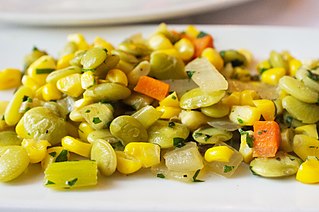
Succotash is a culinary dish consisting primarily of sweet corn with lima beans or other shell beans. Other ingredients may be added including tomatoes, green or sweet red peppers, and okra. Combining a grain with a legume provides a dish that is high in all essential amino acids. Because of the relatively inexpensive and more readily available ingredients, the dish was popular during the Great Depression in the United States. It was sometimes cooked in a casserole form, often with a light pie crust on top as in a traditional pot pie. Succotash is a traditional dish of many Thanksgiving celebrations in New England as well as in Pennsylvania and other states. In some parts of the American South, any mixture of vegetables prepared with lima beans and topped with lard or butter is called succotash. Corn (maize), American beans, tomatoes, and peppers are New World foods.

Lardal was a municipality in Vestfold county, Norway. The administrative centre of the municipality was the village of Svarstad. The parish of Laurdal was established as a municipality on 1 January 1838. The municipality was divided into the parishes of Svarstad, Styrvoll, and Hem.
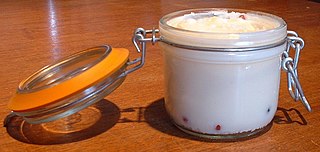
Tallow is a rendered form of beef or mutton fat, and is primarily made up of triglycerides. It is solid at room temperature. Unlike suet, tallow can be stored for extended periods without the need for refrigeration to prevent decomposition, provided it is kept in an airtight container to prevent oxidation.
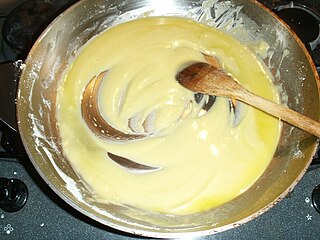
Roux is flour and fat cooked together and used to thicken sauces. Roux is typically made from equal parts of flour and fat by weight. The flour is added to the melted fat or oil on the stove top, blended until smooth, and cooked to the desired level of brownness. Butter, vegetable oils, bacon drippings or lard are commonly used fats. Roux is used as a thickening agent for gravy, sauces, soups and stews. It provides the base for a dish, and other ingredients are added after the roux is complete.

Spermaceti is a waxy substance found in the head cavities of the sperm whale. Spermaceti is created in the spermaceti organ inside the whale's head. This organ may contain as much as 1,900 litres (500 US gal) of spermaceti.
William Frederick "Bill" Rieflin is an American musician.

Pączki are filled doughnuts found in Polish cuisine.

An effigy is a representation of a specific person in the form of sculpture or some other three-dimensional medium. The use of the term is normally restricted to certain contexts in a somewhat arbitrary way: recumbent effigies on tombs are so called, but standing statues of individuals, or busts, are usually not. Likenesses of religious figures in sculpture are not normally called effigies. Effigies are common elements of funerary art, especially as a recumbent effigy in stone or metal placed on a tomb, or a less permanent "funeral effigy", placed on the coffin in a grand funeral, wearing real clothing.

Lost-wax casting is the process by which a duplicate metal sculpture is cast from an original sculpture. Intricate works can be achieved by this method.

For pommades in perfumery made from plant extracts, see enfleurage

Schmaltz is rendered (clarified) chicken or goose fat used for frying or as a spread on bread in Central European cuisine, and in the United States, particularly identified with Ashkenazi Jewish cuisine. Rendered waterfowl fat is also used in the cuisine of Southwestern France. As an effect of cross-cultural influences of the Jewish Ashkenazi, Polish, and Ukrainian cuisine, it is also popular in Poland and Ukraine, where rendered fats are called smalec, with schmaltz derived from geese being popular as gęsi smalec.

A lardon, also called lardoon or larding, is a small strip or cube of fatty bacon, or pork fat used in a wide variety of cuisines to flavor savory foods and salads. In French cuisine, lardons are also used for larding, by threading them with a needle into meats that are to be braised or roasted. Lardons are not normally smoked, and they are made from pork that has been cured with salt.
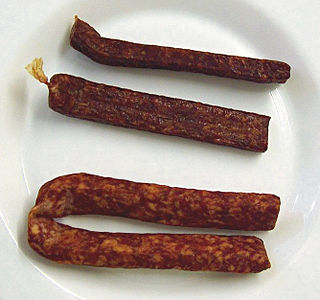
Landjäger is a semidried sausage traditionally made in Southern Germany, Austria, Switzerland, and Alsace. It is popular as a snack food during activities such as hiking. It also has a history as soldier's food because it keeps without refrigeration and comes in single-meal portions. As a meal, landjäger sausage can be boiled and served with potatoes and fresh greens.

Humita is a Native American dish from pre-Hispanic times, and a traditional food in Bolivia, Chile, although their origin is unclear. In Chile, they are known as humitas, in Bolivia as humintas, in Brazil as pamonha, and in Venezuela as hallaquitas. It consists of masa harina and corn, slowly steamed or boiled in a pot of water.
An oil is any nonpolar chemical substance that is a viscous liquid at ambient temperatures and is both hydrophobic and lipophilic. Oils have a high carbon and hydrogen content and are usually flammable and surface active.
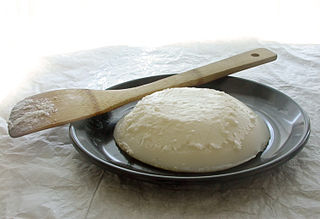
Lard is fat from a pig, in both its rendered and unrendered forms. It is a semi-soft white fat derived from fatty parts of the pig, with a high saturated fatty acid content and no trans fat. Rendering is by steaming, boiling, or dry heat. The culinary qualities of lard vary somewhat depending on the origin and processing method. At retail, refined lard is usually sold as paper-wrapped blocks.

Frittula is a traditional Sicilian street food from Palermo. It is similar to the frìttuli from Calabria, but seems to use calf parts instead of pig.

